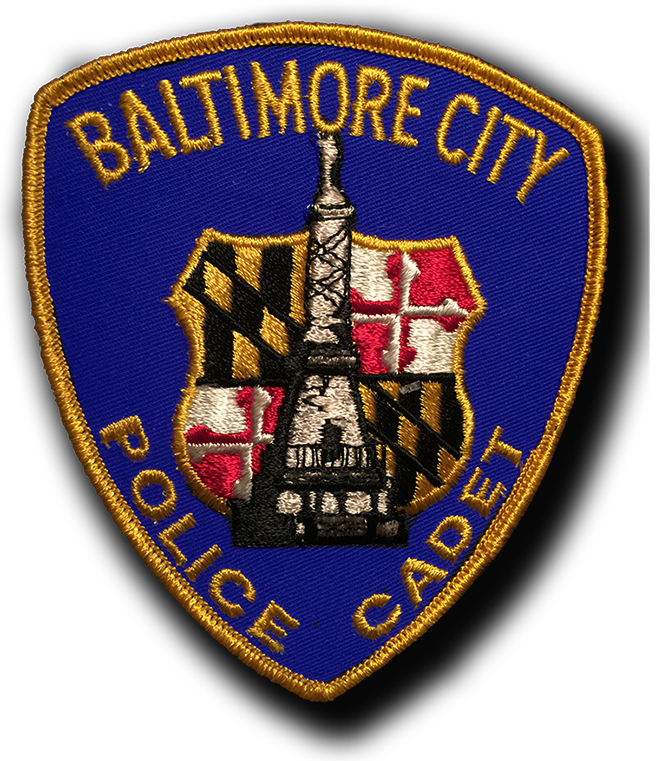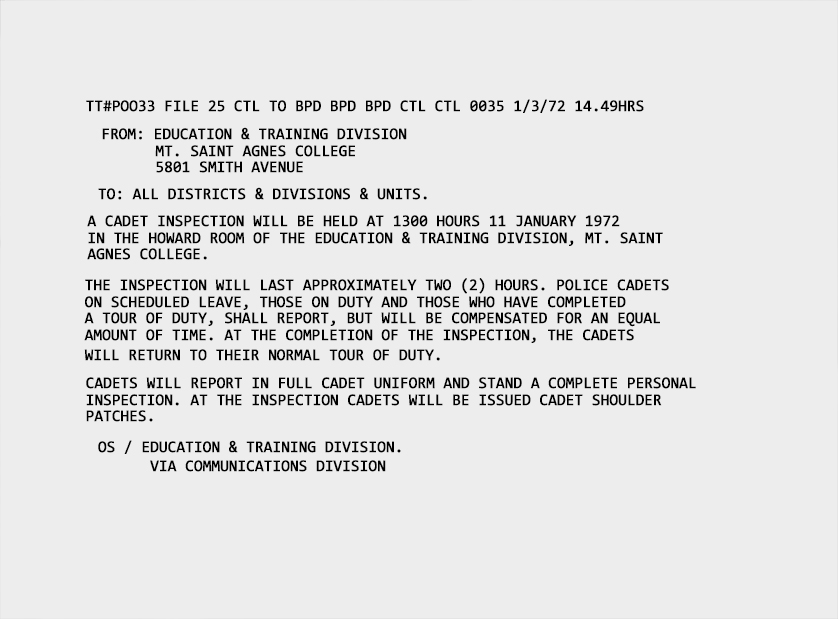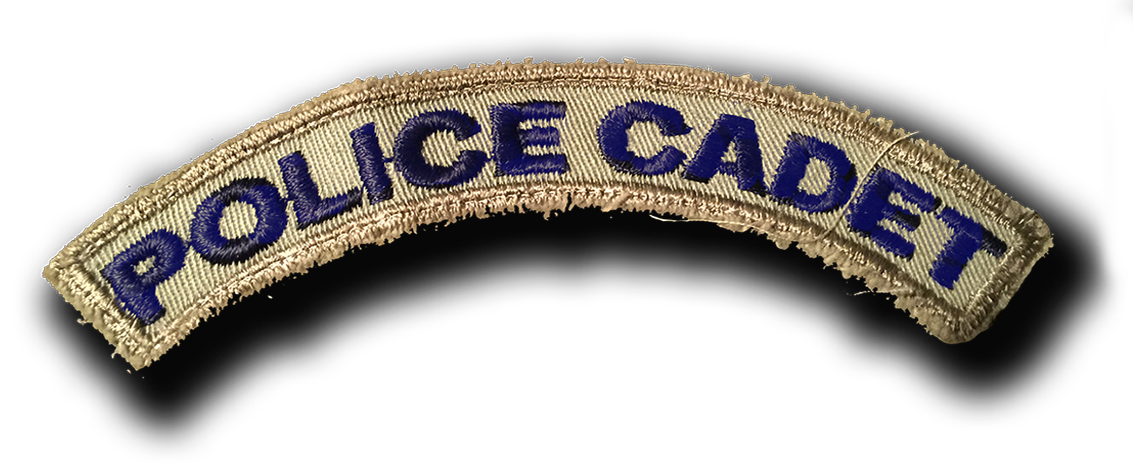The Cadet program was something that other agencies had done for years, and Baltimore had been trying to establish to help free up patrolman from desk jobs and put them back or the streets. While cadets handled these tasks formerly handled by police, such as answering phones, filing reports, pulling reports, warrants, etc. they were also being groomed to become police, a sort of test drive, for the department to see if the cadet had what it took, and to see if the police work was what the cadet wanted out of life. Likewise, this got the youth a job within the department while they were young and before they were hired by someone else or found a different field to work in.
 Stamp Made in Photoshop shows P/O Chuck Bealefeld getting his Cadet Badge
Stamp Made in Photoshop shows P/O Chuck Bealefeld getting his Cadet Badge
Baltimore's Police Department's
Cadet Program
The Cadet Program Started on 17 June 1965, the first Cadet patch was a grey and blue rocker patch, which was changed to the more modern looking patch but with the word CITY on the patch; this change and the removal of the grey stripe down the pant legs took place on 11 January 1972
The Cadet program was something that other agencies had done for years, and Baltimore had been trying to establish to help free up patrolman from desk jobs and put them back or the streets. While cadets handled these tasks formerly handled by police, such as answering phones, filing reports, pulling reports, warrants, etc. they were also being groomed to become police, a sort of test drive, for the department to see if the cadet had what it took, and to see if the police work was what the cadet wanted out of life. Likewise, this got the youth a job within the department while they were young and before they were hired by someone else or found a different field to work in.
The first Cadet ever hired was Edmund Bossle, he was hired on 17 June 1965, at the age of 19, and given the badge number #101, a success story, as he would go on to become a Patrolman with the badge number of #100, then a Detective, badge #84, Sergeant badge #442 and Lieutenant badge #115 He had an old sequence number of #6262, which was replaced with what became nicknamed a “short number” of A-894. His career proved the system worked as far as retaining and promoting talent in the department through the cadet program.
 Police Cadet Reefer Coat Circa 1965 to 1972
Police Cadet Reefer Coat Circa 1965 to 1972This is the order issued 3 January 1972 telling cadets to report on 11 January 1972 for inspections and to be issued the new Cadet patch. It was to take the place of the grey rocker patch. the same day they informed cadets that they would no longer need the grey stripes down their paint legs. Below is a picture of the Rocker Patch, followed by the CITY Cadet patch and then the current Cadet patch.
This is the Cadet Rocker patch issued from 1965 - 1972

The Second Cadet Patch Would Look Like This.
Like the Officer's patch of the same time with the word "CITY"
1972 until 1974
 1974 - Present
1974 - Present

48 Police Cadets in Courses
22 Sept 1967
48 city police have begun mandatory classes in law enforcement at Baltimore junior-college under a department financed program which could lead to associate of arts degree for each cadet. The program requires that each of the departments but that’s thick six semester hours of courses during the fall and spring semesters and at least three hours during the summer months. In addition to the 40 the start of the program, an additional 11 Cadets have already been taken horses at the junior-college or at Morgan state college. Six men now in the police academy who began his Cadets are also taking college courses under the program.
$5200 a Semester
From departmental training funds, each student’s tuition of $89 and book expenses of about $15 will be paid, making total cost of the department for each semester of about $5200 The police cadet program was initiated in the city in 1965. A youth can become a cadet at the age of 18 and then entered the police Academy at the age of 21 to become a full-fledged patrolman. Under the present schedule, a fit that who begins the college program at the age of 18 and about two-thirds the credits needed for an associate of arts degree in law enforcement. In order to remain at the deck, the Cadet must maintain passing grades in his classes.
Starting Courses
That’s just starting to classes will take courses in English and sociology. Donald D. Pomerleau, Police Commissioner, said he feels “education and training and mandatory college programs for the debts will ensure that we have a constant flow of intelligent young man entering the department.” He said, “if where to get the very most out of our cadet program, it is necessary that would make it mandatory for them to unfold in a police administration course.” Under the program, the Cadets have been divided into two groups, half of which will take classes on Monday and Wednesday nights the other half will attend on Tuesday and Thursday nights.

The Third Cadet Patch in Time with the City Officer's Patch
Having the Word CITY Removed

POLICE INFORMATION
If you have copies of: your Baltimore Police Department Class Photo, Pictures of our Officers, Vehicles, Equipment, Newspaper Articles relating to our department and or officers, Old Departmental Newsletters, Lookouts, Wanted Posters, and or Brochures. Information on Deceased Officers and anything that may help Preserve the History and Proud Traditions of this agency. Please contact Retired Detective Kenny Driscoll.
This email address is being protected from spambots. You need JavaScript enabled to view it.

NOTICE
How to Dispose of Old Police Items
Please contact Det. Ret. Kenny Driscoll if you have any pictures of you or your family members and wish them remembered here on this tribute site to Honor the fine men and women who have served with Honor and Distinction at the Baltimore Police Department. Anyone with information, photographs, memorabilia, or other "Baltimore City Police" items can contact Ret. Det. Kenny Driscoll at This email address is being protected from spambots. You need JavaScript enabled to view it. follow us on Twitter @BaltoPoliceHist or like us on Facebook or mail pics to 8138 Dundalk Ave. Baltimore Md. 21222
Copyright © 2002 Baltimore City Police History - Ret Det Kenny Driscoll
You May Like


 Police Cadet Reefer Coat Circa 1965 to 1972
Police Cadet Reefer Coat Circa 1965 to 1972























